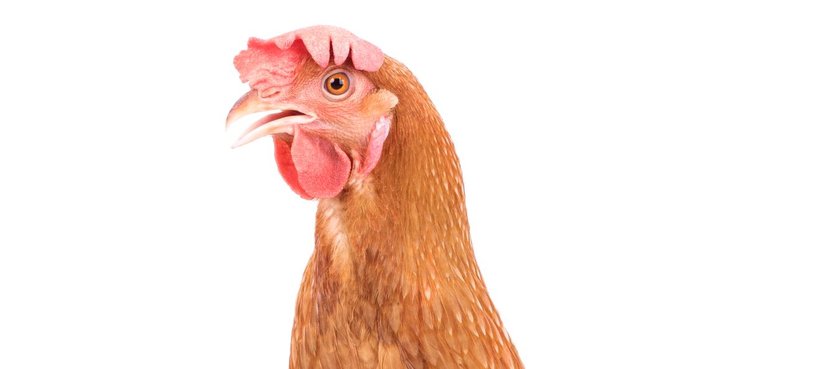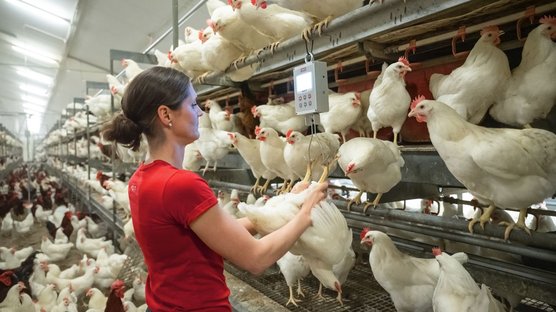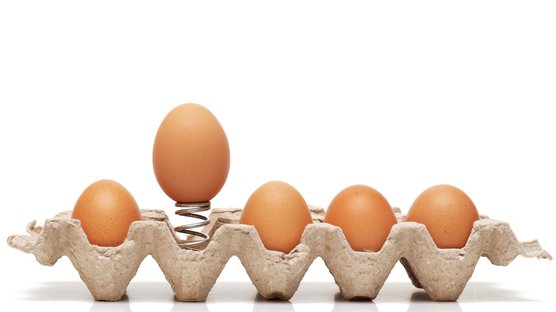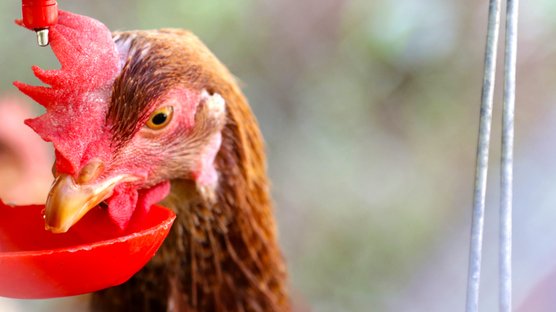
Published on Oct. 15, 2021
Understanding the chicken
Laying hens are warm blooded (homeothermic) animals, that means that they can maintain their body temperature constant, i.e. within a certain range. On average, the body temperature of healthy chickens falls within the range of 40 - 42°C. The thermal neutral zone for adult laying hens ranges from 18 °C to 24 °C (ambient temperatures), this means that within this temperature range the birds do not need to modify their metabolism to stay warm or to get rid of the heat. For newborn chickens it takes some time before their heat regulating mechanisms can function normally, that is the main reason why the young birds need higher ambient temperatures during the first weeks of their life. Directly linked to that is their lack of body reserves (especially fat), and the ratio of the surface area vs. their bodyweight is unfavorable, resulting in heat losses.
When house temperatures are not within the thermal neutral zone, chickens have several characteristics that enable them to keep their body temperature constant without the need to produce extra heat. These characteristics include:
- Feathers, they have an insulating effect and help to prevent the chickens from excessive heat loss
- Tissue insulation, subcutaneous fat will allow the hens to drop their skin temperature whilst not negatively affecting their body temperature.
- Adapt the blood flow through the skin (including combs and wattles), chickens can regulate the widening and contraction of their blood vessels. In order to lose more heat, the blood flow will be enlarged
- Huddle together to minimize the loss of heat
- Ability to increasing the body surface to lose more heat

Keep in mind: a young chick has relatively the largest contact surface with the surrounding air, therefore they can cool off much quicker compared to an adult laying hen.
The Five ways to keep cool
Chickens regulate their body temperature via their hypothalamus, which is a part of the brain that is comparable to a thermostat. Heat emission and heat retention is largely influenced by the contraction and widening of the blood vessels and the speed of respiration. Chickens do not have sweat glands; therefore, they are not able to lose their heat via transpiration. They do are able to lose their heat themselves via different pathways:
- Radiation
- Convection
- Conduction
- Evaporation
- Vasodilation
Radiation, convection, and conduction are all 3 related to sensible heat loss. Sensible heat is the energy required to change the temperature of a substance with no change of phases. The loss of body heat comes from the contact with the cooler surrounding air, that absorbs the heat of the birds. Chickens are normally able to maintain their normal body temperature of 40 - 42°C via sensible heat loss when the environmental temperature falls within their thermal neutral zone of 18 – 24°C. When the barn temperature rises above 25°C the efficiency of sensible heat loss is going down, and at 35°C it has hardly any effect unless the relative humidity is low. Management plays a vital role in maintaining your chickens body temperature within their comfort zone.
Chickens can lose heat to the surrounding air, this is called convection or radiation, which permits the transfer of body heat to the air. Proper ventilation, which results in faster air movement inside the poultry house, will result in better heat loss due to convection. As long as the ambient air temperature is colder than the chicks’ body temperature the aforementioned will work. Therefor cooling the incoming air will result in improved radiation. But keep in mind, the smaller the difference between the body temperature of the chickens and the ambient temperature gets, the lower the possibility for proper heat loss gets. This is also true for humidity, the amount of moisture that the birds can evaporate becomes smaller when the humidity gets up.
Next to panting, chickens can increase their heat loss by extending their wings and putting up their feathers (they become fluffy). This will allow more air to circulate near the body (especially the skin), and it increases the contact surface with the surrounding air to expel the heat. As mentioned earlier, laying hens can regulate their blood circulation to lose heat. They can increase blood circulation in their comb, wattles, and skin to lose more heat to the cooler surrounding air (called vasodilation). Always reconsider the aforementioned prior to asking for dubbed roosters as it can negatively influence the bird’s health and welfare under situations of heat stress.
The above mechanisms can only work when management is properly adopted to the needs of the laying hens. Changes in water and feed management, like adding vitamins or buffers can impact about 15% of the heat stress, much larger impact (85%) can be made via managing the climate in the poultry house via ventilation. As this will better help your flocks in dealing with too high and too cold temperatures via the management of the flock.
Heat stress occurs when the chickens’ core body temperature increases to fatal temperatures because of poor heat loss. Chickens are not that well capable to cope with high body temperatures, therefor severe heat stress can cause increased mortality of the flock. Both temperature and the relative humidity play a crucial role in the occurrence of heat stress. It is key to measure an monitor both carefully.

As laying hens cannot sweat, they use evaporation (latent heat) to stabilize their body temperature by increasing their respiration rate. The latent heat of evaporation is the heat required to change ware into water vapor. The water vapor is taking away the heat from the hens’ body. This behavior is better known as “panting”. Panting can only be effective when the relative environmental humidity is not too high. The evaporation of 1 gram of water results in a heat loss of over 500 calories! Losing heat also comes with a cost, as the chickens need to expend their energy in trying to maintain their body temperature below 42.5°C. as it is pretty hard to compensate for this higher energy requirement via their nutrition, you’ll likely see a reduction in growth, body weight and production performance.
Keep in mind: chickens do not have sweat glands, therefor they are not able to lose their heat via transpiration. When a chicken wants to cool down, she will start panting. Via panting with her beak open (you can see the birds’ throat rapidly moving backwards and forwards) the bird is able to get rid of the excess heat as the panting enables moisture to evaporate through the airways. Next to the panting, the birds will hold their wings out slightly from their bodies and they raise their feathers to maximize the skin contact with air to expel the heat.
As heat stress is already a stress on its own, it is important not to stress your birds any further. We have listed some practical tips and tricks below, often easy to implement and at a low cost.
- When chick handling is required (vaccination, transfer, sorting, depopulation) it is advised to do this in the early mornings.
- When transporting the chickens, place fewer birds in crates and place empty crates in the truck to enhance ventilation during transport. Try to minimize the drive and drive during late nighttime and early morning
- Try to avoid disturbing the laying hens during the hottest part of the day, disturbance results in even more stress to the chickens
- Respect the stocking densities carefully, both in cage and floor housing systems. Too high stocking densities could reduce the effectiveness of ventilation and creates competition for water and feed. In general, cage chickens are more susceptible to heat stress as they are not able to find themselves a cooler place.
The relationship between heat stress and eggshell quality
As a result of heat stress, the laying hens body temperature can rise above the 42.5°C. As a result of panting (hyperventilation), the laying hens will loose extreme amounts of CO2. This extreme loss will cause a rise in the pH of the blood, i.e., the blood will become alkalotic and causing metabolic alkalosis. This will cause low concentrations of blood calcium. As the blood pH increases, blood transport proteins, such as calbindin, become more ionized into anions. This causes the free calcium present in the blood to bind more strongly with the calbindin, resulting in less availability of calcium and phosphor for the eggshell formation and reduced secretion of calcium and carbonate by the shell gland.
Tip: adding Vitamin C, Vitamin E and H₂CO₃ to the diets can help to prevent the blood from becoming alkalotic.




